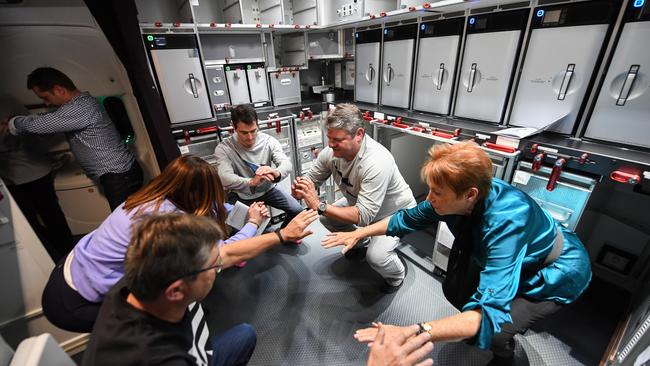For Qantas, the future of long-haul air travel may be the Macarena

In the middle of the night, on the longest commercial airline flight attempted with passengers, about a dozen people danced the 1990s pop craze down the aisle of a Boeing 787 in airline-issued pyjamas.
But this was no slumber party. It was serious research on how to defeat jet lag and keep people healthy if they are going to sit on a passenger plane for most of a full day.
The record-setting 16,000km non-stop flight from New York to Sydney is farther than current aircraft can fly with a full load and beyond what current regulations allow, but Qantas is pushing towards launching New York-Sydney and London-Sydney non-stop.
These routes will revolutionise travel.
Qantas believes the research flight is the first time crew and passengers have been extensively monitored biologically on an airline flight.
Researchers used brain-activity monitors on pilots while they flew. They also tested their levels of the hormone melatonin, which makes you sleepy, every four hours.
Passengers and crew did response-time tests on tablet computers and wore monitors on wrists to measure heart rates and physical activity, which included stretching exercises in the rear galley, squats in the aisles and a loud parade with goofy dance moves.
Jet lag contributes to cardiovascular disease, obesity and diminished immune-system functioning, says Marie Carroll, a professor at the Charles Perkins Centre, a University of Sydney organisation focused on health. She is leading the passenger research.
Qantas had 49 people, including me, aboard, all seated in business class.
Carroll’s team designed a radically different schedule for cabin service to reset body clocks quickly to Sydney time.
Typically on long flights, airlines serve a carb-filled meal after takeoff, then darken the cabin for sleep. This time, researchers wanted to keep passengers awake for at least six hours after the 9.27pm takeoff from New York’s Kennedy Airport, then hope passengers had a long, uninterrupted sleep before the morning arrival in Sydney.
Cabin lights stayed bright deep into the night. A spicy meal arrived with caffeine after takeoff to ward off slumber. Exercise sessions, including Macarena hand movements and hip swivels, were held to keep passengers awake, blood circulating, and muscles and joints flexible.
When it was time for sleep, a meal full of carbs and creams was served with wine, chased by Sleepytime tea. Then the cabin went from bright to blackout.
“I got almost eight hours of sleep without assistance — no alcohol or sleeping pills,” says Nick Mole, a Sydney investor in private companies and one of the six Qantas frequent flyers who agreed to switch their booked flights home to the research flight to avoid a three-hour stop in Los Angeles.
Participants kept a log of their sleep seven days before the trip and agreed to continue two weeks after the flight. It can take up to two weeks for jet lag symptoms to dissipate.
Mole started doing reaction-time tests on an iPad in New York to set his baseline, then did the test, a standard alertness measurement used with truck drivers, shift workers and others, three times in the air. The first score after departure was his best. After staying awake six hours, to 3.30am New York time, he recorded his worst score.
An hour before arrival, he aced the test with his second highest score.
“I can’t say I ever felt more alert after a flight than when I started,” he says.
But Mole is sceptical that sedentary passengers will regularly start doing standing push-ups against food-storage lockers in an aeroplane galley. “Whether or not Qantas lets 230 people do the Macarena every hour remains to be seen,” he says.
Carl Petch, a Sydney-based video-networking manager who travels worldwide for business, found himself enjoying the exercise. “It could be a unique thing to do on a long flight,” he says. He, like the other test subjects, arrived feeling more awake and refreshed than on other trips.
Still, the exercises were a tough sell initially. Four hours into the flight, Carroll, the researcher who doubled as in-flight exercise guru, fretted that her test subjects weren’t moving enough. Not hard to figure when the choice is squats in a narrow aeroplane aisle or 1000 movies.
She fired up a recording of the Macarena and had test subjects, the airline’s pyjama-clad chief executive and others dancing.
Qantas hopes to start the marathon non-stops in 2023. “I’m convinced there is a commercial business case for this,” Qantas chief executive Alan Joyce says. As for the Macarena, he’s a believer in that as well. “I think it’s the first time it’s ever been done, certainly on a long-haul flight,” he says. “So maybe we’ll make a trend of it — maybe it can become a signature of Qantas.”
The Wall Street Journal



The key to the future of long-distance air travel just may be the Macarena.